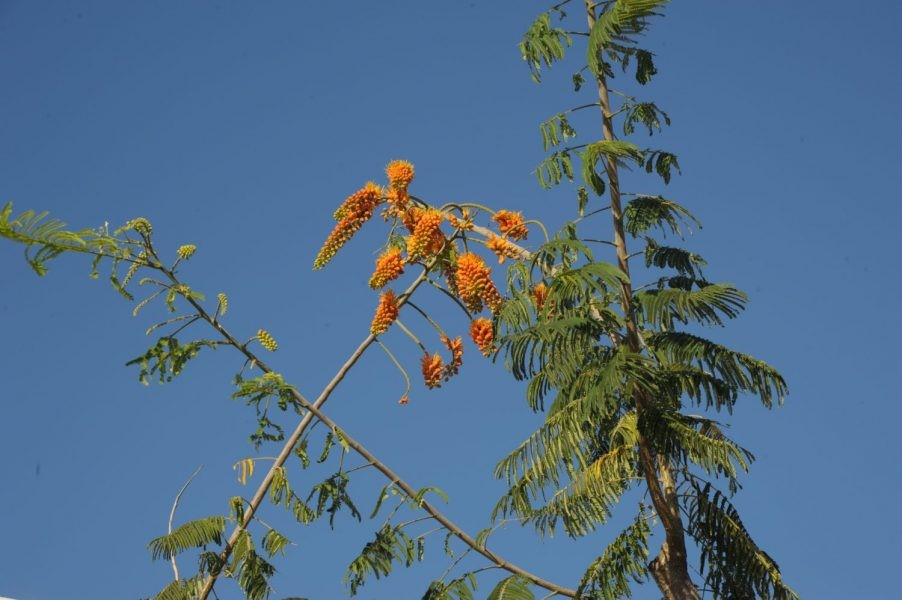

Colville’s Glory, or Colvillea racemosa, is a glorious tree that you don’t see all that often on Grand Cayman. This could be because, to the untrained eye, it looks almost identical to the Delonix regia, or Royal Poinciana, which is prominent all over the island. If you take a closer look, you will notice some subtle, but identifiable differences in the two. The bark, the height and the canopy spread are all slightly different. But the real difference is in their flowers.
Although Colville’s Glory also bears an orange flower like the D. regia, it comes in the form of a giant velvety cluster that resembles a cone. A member of the legume, or Fabaceae, family, it too produces long, flat pods for its seeds.
The pollinators of Colville’s Glory include sunbirds which are commonly seen on Grand Cayman, such as the bananaquit and vireo.
Named after an ex-governor of Mauritius, Charles Colville, Colville’s Glory is native to Madagascar. It is widely used today as an ornamental in places across the globe that can mimic its native habitat of lowland forests and savannahs. It is a great addition to the landscape and is very drought tolerant once established.
Colville’s Glory performs best in a sunny location and it can tolerate a range of soils, making it perfect for the Cayman Islands.
This tree reaches heights of 30 to 50 feet, and it is important to give it enough room to grow and thrive as it does not like to be crowded. Colville’s Glory is deciduous, meaning it loses its leaves for a period of time each year.
It flowers in the winter months, which is another factor to consider from a design standpoint. Although some find a naked tree an eyesore, it is important to remember that this is a time to appreciate the beauty in the form of the tree and the interesting seed pods.
Colville’s Glory is not particularly useful as timber, since it is a light wood, but it can be used to build small furniture, such as storage boxes and end tables. Perhaps its most useful quality has not yet been widely exploited, as it has recently been discovered that it is a fantastic tree for reforestation. It establishes quickly, is low maintenance and drought tolerant, and shows no signs of being potentially invasive. This is a good tree specimen to keep in mind for landscaping, especially on a small island such as Grand Cayman, as development continues.
In Camana Bay, Colville’s Glory can be seen at the bottom of the Rise on the Seven Mile Beach side, directly next to the Esterley Tibbetts Highway underpass.
This article originally appeared in the December 2019 print edition of Camana Bay Times with the headline “Focus on Flora: Colville’s Glory.”

About the author
Shannon Schmidt is the Horticulture Manager at Dart’s Arboretum Services Ltd. Joining Dart in 2012, Shannon previously worked in parks, public gardens and tourism properties, among others. Originally from the Finger Lakes region of New York State, Shannon loves island life, spending time paddleboarding around the canals and mangroves, in the sea, and spending time outdoors with her two energetic Boston Terriers Nollie and Ebbie and her equally energetic partner Chase! Shannon holds a Bachelor of Science in Recreation, Park and Tourism Management from The Pennsylvania State University and a Diploma in Horticulture from the Longwood Gardens Professional School of Horticulture, and loves spending time swinging in a hammock, with her favourite smoothie from Jessie’s Juice Bar and reading material from Books & Books.